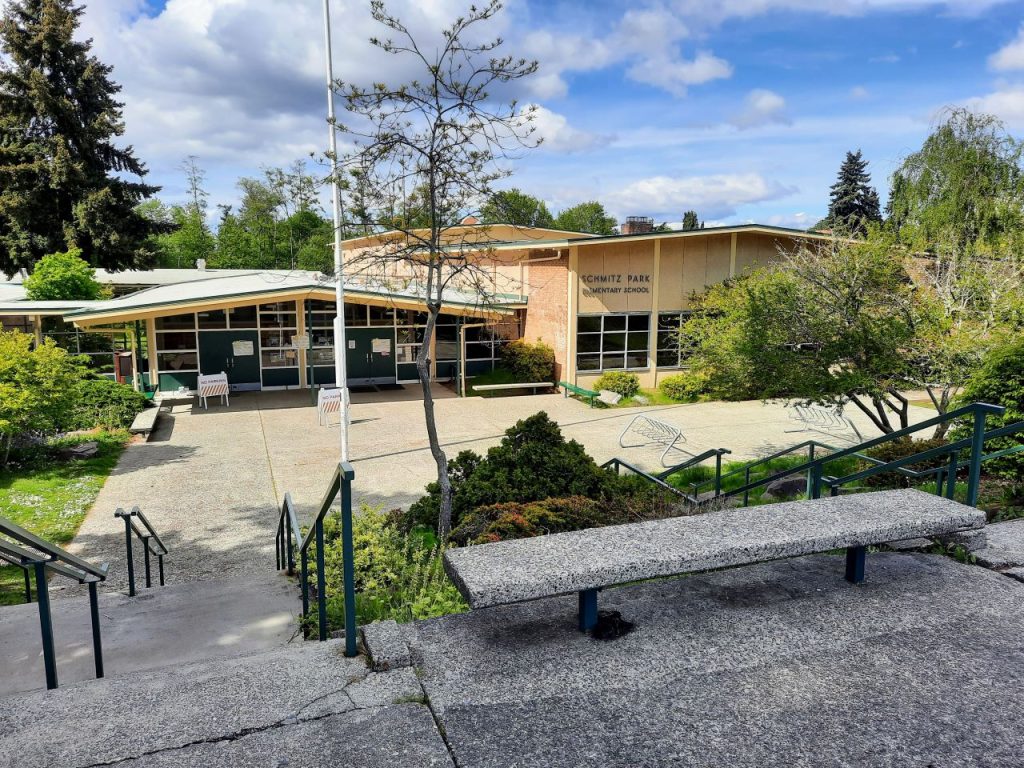
Last week Seattle Public Schools (SPS) unveiled plans to embrace sweeping austerity, making major cuts to school programs and closing an unspecified number of schools in the 2025-26 school year. In response to a new wave of community organizing against austerity plans, the district abandoned plans to close schools in the 2024-25 school year.
Unfortunately, the district’s plans would repeat damaging mistakes made in Chicago 10 years ago when it closed 50 public schools. Research from Chicago’s experience and other cities that have closed public schools shows that it does not solve district budget woes or leave remaining schools with more resources, but it does harm students whose schools are closed.
Public schools are foundational to a city and are important parts of our neighborhoods. Closing them or making major cuts to them has a ripple effect on the city as a whole. As Seattle works to build more infill housing and attract more families to our city, cuts and closures to our schools could undermine that important work and harm students already living here. Community groups are now pushing the legislature to use more than $1 billion in extra revenue to help Seattle and other school districts avoid budget cuts.
SPS’s financial stabilization plan
Seattle Public Schools unveiled a draft “financial stabilization plan” at their board meeting on Wednesday, November 15. SPS faces a budget deficit of more than $100 million for the 2024-25 school year, caused by a combination of cuts to state funding, the end of federal stimulus funding, and loss of enrollment during the pandemic.
The financial stabilization plan contains two primary elements: major yet unspecified cuts that would impact classrooms across the district, and school closures. Importantly, school closures would not save a significant amount of money, as will be discussed later in this article. Cuts for the 2024-25 school year include:
- Reductions and adjustments in central office staffing and expenses;
- Reductions and adjustments in school staffing allocations;
- Changes to transportation;
- Fees;
- Lease or sale of non-school properties;
- Program adjustments and restructuring;
- Delayed repayment of the Economic Stabilization Fund;
- Reductions in contingency balances; and
- Utilization of one-time self-help funds and school carryforwards.
Of these, reductions to school staffing allocations (meaning larger class sizes and fewer course offerings) and vague “program adjustments and restructuring” would have the most direct impact to students. However, SPS did not provide the public any further detail to explain what these reductions and adjustments would mean in practice or how much money they would save.
“Changes to transportation” would reportedly involve a two-tier bus schedule and school start times. SPS attempted to make this change in the spring of 2022, but abandoned that effort in the face of stiff public resistance. SPS has not studied the impact of a two-tier bus schedule on student transportation, and we do not know if it would cause an increase in the number of students being driven to school.
The financial stabilization plan also mentions three major, yet unspecified, cuts that would take place in future years:
- School consolidations, to be implemented in the 2025-26 school year and beyond;
- Grade level reorganizations; and
- Program adjustments and restructuring.
“School consolidations” are how SPS describes school closures. The meaning of “grade level reorganizations” is unclear but could include eliminating K-8 schools, creating K-2 schools, or other sweeping changes.
Notably, SPS acknowledges that this plan “was not reviewed with the district Racial Equity Analysis Tool,” though they pledge to do so in the future. No budget analysis or specific dollar amounts were provided to the public to understand the impact of these changes. Neither has the district done any analysis of the possible impact to student learning.
SPS hopes to have this plan approved by the new school board as one of their first actions in office at the December 13 board meeting. Community groups have instead asked the board to hold off on approving the plan until after the 2024 legislative session in order to try and push legislators to provide more funding so as to avert these cuts.
What happened when Chicago closed 50 schools
In 2013 Chicago Mayor Rahm Emanuel announced that the city would close 50 public school buildings. (At the time, the mayor of Chicago appointed the school board.) Emanuel justified his plan in similar ways to how SPS leaders are justifying their plan – claiming it would help save money, increase enrollment, and improve student outcomes.
The results were devastating — for students, for neighborhoods, and for the public school system itself.
A 2018 study by the University of Chicago found that students whose schools closed had worse grades, and that students in both closed and “welcoming” schools saw long-term drops in test scores. A 2023 analysis by the Chicago Sun-Times and WBEZ found that students from closed schools also had lower SAT scores, lower graduation rates, and higher dropout rates. Many students whose schools closed “never had a stable school situation again.”
Research on the impact of school closures on neighborhoods has been more sparse. A 2021 study from UC Davis found that schools that were closed and merged into other schools saw higher rates of nonviolent crime compared to other neighborhoods.
Chicago Public Schools did not reap the financial or enrollment rewards promised when closing schools. Enrollment in Chicago Public Schools has never recovered. Nor did CPS experience any financial benefits. The district’s structural revenue deficit grew larger, from $6.4 billion in 2013 when schools closed to $8.6 billion in 2023. The act of closing schools also created significant costs for CPS related to moving students and maintaining shuttered buildings that helped eliminate any savings.
These combined factors led researchers to conclude that “Closing under-enrolled schools may seem like a viable solution to policymakers who seek to address fiscal deficits and declining enrollment, but our findings show that closing schools caused large disruptions without clear benefits for students.”
Similar research conducted this fall in San Antonio further bolsters the conclusion that closing schools is harmful to students. The San Antonio Independent School District closed several schools in 2014, and is now planning to close 15 more for the upcoming school year. Under public pressure, San Antonio schools brought in University of Texas-Austin education policy professor Dr. Terrance L. Green to conduct an external equity report on the closure plan. Dr. Green found that students who were in 5th grade when their schools closed experienced lasting damage in math and English language arts. He concluded that “closing schools does not make the district more equitable.” Nevertheless, San Antonio’s school board proceeded to close 15 schools by a 5-2 vote last week.
Both the San Antonio equity audit and the University of Chicago study also found that school closures most negatively impacted students who were in the 5th grade when their school closed. Under SPS’s plan, students who started kindergarten during remote learning in 2020-21 would be in 5th grade in 2025-26 and could see their schools close again.
Mayor Emanuel’s school closure plan stoked widespread yet unsuccessful public opposition. One organizer, a teacher named Brandon Johnson, led a protest march to City Hall against the closures. Earlier this year, Johnson was elected mayor of Chicago. Community members also mobilized to end mayoral control and return an elected school board to the city beginning in 2024.
Seattle closures don’t add up
Despite the explicit warnings found in research on school closures, Seattle Public Schools leaders appear determined to proceed with closures anyway. Yet their arguments do not stand up to close scrutiny, and district leaders often engage in a constantly-shifting set of arguments to try and defend their plans.
SPS has admitted that closing schools is not going to solve their budget crisis. Instead, they have explicitly said they want to close schools regardless of the budget. It’s something district leaders actively believe is a good thing. SPS Chief Operating Officer Fred Podesta explained in February that “consolidating into larger schools that have the resources they need is a good strategy whether you have money problems or not.”

In August Superintendent Brent Jones told the Seattle Times that closing schools won’t solve the district’s $100 million deficit for the 2024-25 school year: “Consolidating schools won’t fix the district’s budget problems,” Jones said, adding that district administrators have projected closing schools could save $20 million, but that’s a rough estimate and savings may not come until two to five years later.
At a board work session in October, SPS administrators claimed that closing schools could save anywhere between $750,000 and $2 million per building in future years. This was not accompanied by any detailed analysis that the public could examine themselves. Even if these numbers are accurate, it’s clear that closures alone would not solve the district’s ongoing financial woes. SPS would have to close at least 50 of its 110 schools to close the budget deficit entirely without making any other budget cuts.
SPS leaders have also suggested that if some schools were closed, remaining schools might somehow be able to have plenty of resources for the programs families want.
This is unlikely to happen in Seattle, just as it did not happen in Chicago. In the absence of new state funding, SPS will still have to make roughly $100 million in budget cuts for the 2024-25 school year. These cuts will eviscerate existing programs and services, as described above. The result will be that the schools which remain open will likely have similar services and staffing levels as they do today — but with much larger student populations.
SPS leaders have also been incorrectly claiming that the state’s prototypical school model, which determines how school districts are funded, requires schools to have enrollments of at least 400 students. Shortly before the election, the Seattle Times quoted school board director Liza Rankin:
“The district’s elementary schools must each have an enrollment of about 400 students, based on the state formula, she said. That’s why Rankin thinks the district must consider consolidation.”
Such statements are a misinterpretation of state law. The RCW is explicit that the prototypical school model is not to be used to determine the enrollment at a given school, and instead is simply a way to determine how to send money to school districts. The prototypical school model also bases high school funding on an enrollment of 600 students. If SPS were to use that as a basis for high school size, the district would need to open a half dozen new high school buildings.
Further, the prototypical school model has come under repeated attack over the last decade by advocates who point out the numerous ways in which it shortchanges schools and students. It’s entirely possible that sometime this decade it will be scrapped and replaced by a different funding model. That means it makes even less sense to use the prototypical school model to justify closing schools.
Seattle families mobilize to fight back
In response to recent classroom cuts and looming school closures, families across Seattle have mobilized in a loose coalition to fight against future cuts and to demand that the district postpone any financial decisions until after the 2024 legislative session.
One school community that has been particularly active is at Dunlap Elementary in Rainier Beach. A broad, multiracial group of Dunlap parents was featured in the Seattle Times last week. Dunlap lost teachers in October after the school year had already begun, as did dozens of schools across the city. Dunlap parents and teachers pleaded with the school board and district administrators to prevent these cuts, but the cuts went ahead.
“Our biggest call to action is that we want to be partnered with, we want to be heard and included, we want whatever budget proposals that come down to be co-created by the community,” said Alex Wakeman Rouse, one of the Dunlap parents and a member of the new All Together for Seattle Schools coalition in the Times article.
Sarah Nau, a parent of two SPS students in Lake City, wrote in a Seattle Times op-ed in early November that “it feels like the district and the board have abandoned their responsibilities to fight for the students entrusted to their care. Instead of ‘punching up’ and advocating/working with legislators for better funding at the state level for all public K-12 institutions in WA, they’ve resigned themselves to ‘punching down,’ leaving the students, staff, and families to deal with the repercussions, whatever they may be (and consequences be damned).”
Extra revenue creates new legislative opportunities
School district budget woes should not be resolved on the backs of children. The state legislature needs to step up with more funding to prevent cuts and closures in public schools in Seattle and across the state. Thankfully, Washington State is bringing in over $1 billion in extra unbudgeted revenue that can be used for this purpose.
On Monday the Economic and Revenue Forecast Council released its latest projection suggesting Washington State will collect an extra $770 million above previous expectations over the next four years, driven by higher sales tax and Business & Occupations Tax revenues.
Further, the state’s new capital gains tax has already collected $900 million in revenue in 2023. Only $500 million of that revenue has been budgeted, going to the Education Legacy Trust Account for early learning and K-12 public schools. That leaves $400 million in extra revenue. Currently, extra capital gains revenue is slated for school construction but it has not been explicitly budgeted for that purpose.
Legislators could decide in the 2024 session to use most of the extra capital gains tax revenue to close K-12 school district budget gaps while also beginning to fund school construction. This could provide a bridge to the 2025 legislative session when a new governor and a new legislature could pass a wealth tax or other progressive revenue source to provide stable, growing funds for public education.
Given these options, it would be unnecessary and premature for SPS to adopt a resolution directing the superintendent to prepare budget cuts and school closures. While there’s nothing wrong with the district continuing to make plans, they should not adopt any firm plans for cuts and closures until after the legislative session ends in March 2024. In the meantime, we can all push the legislature hard to use extra revenue to help our kids thrive and prevent school austerity.
Author’s note: Robert Cruickshank is the president of Washington’s Paramount Duty, a group dedicated to fully funding public schools in Washington State, and he provided messaging support to All Together for Seattle Schools.

Robert Cruickshank
Robert is the Director of Digital Strategy at California YIMBY and Chair of Sierra Club Seattle. A long time communications and political strategist, he was Senior Communications Advisor to Seattle Mayor Mike McGinn from 2011-2013.
